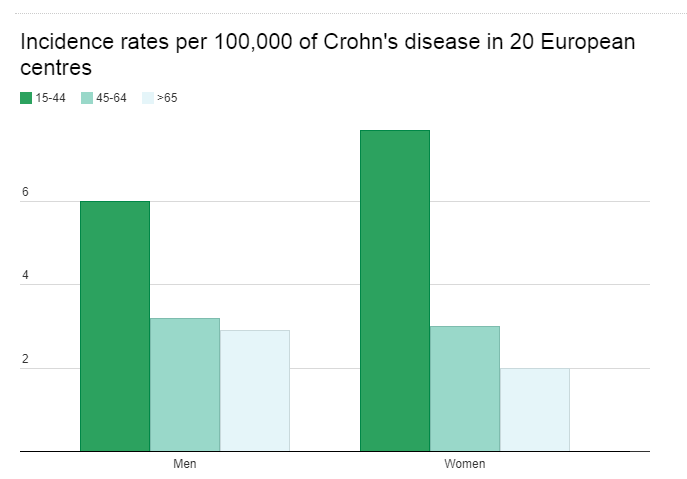Let’s start the day with a little bit of scientific background about Inflammatory Bowel Disease

Inflammatory bowel disease (IBD) is an umbrella term used to describe disorders that involve chronic inflammation of your digestive tract. Types of IBD include:
- Crohn’s disease: This type of IBD is characterized by inflammation of the lining of your digestive tract, which often spreads deep into affected tissues. Crohn’s disease can occur in any part of the gastro-intestinal tract. The terminal ileum / proximal colon are affected in the majority, though disease may co-exist in other locations (foregut, small intestine, colon, and perineum). Crohn’s disease is a lifelong disease, with a fluctuating course characterized by flares and remissions. It often presents in late adolescence or early adulthood, although can occur at any age. Periods of active disease might result in complications such as intestinal fistulae (penetrating disease) or tissue scarring and lumen (the space inside your intestine) narrowing (stricturing disease); patients with no such complications have a pure inflammatory disease course (non-stricturing, non-penetrating disease). Symptoms depend on disease location and behaviour. The most common presenting symptom is loose stool consistency, typically for at least 6 weeks. Other common presenting symptoms are: abdominal pain (in 70%), weight loss (in 60%), iron deficiency and associated anaemia, rectal mucus and bleeding (in 40% with Crohn’s colitis), extra-intestinal manifestations (joint, eye, skin or hepato-biliary disease), perianal fistulas (occur in 10%). Crohn’s disease is more common in developed countries (there is a North-South and West-East gradient). Although it was believed there is no gender bias, recent studies proved a higher incidence of the disease among females, especially at younger ages.

Obtained from ECCO Epidemiology Database (http://www.e-guide.ecco-ibd.eu/resource/incidence-rates-crohns-disease-20-european-centres)
- Ulcerative colitis: This condition causes long-lasting inflammation and sores (ulcers) in the innermost lining of your large intestine (colon) and rectum. Ulcerative colitis describes continuous mucosal inflammation involving the rectum and a variable extent of the colon. Although a lifelong disease, it is characterized by periods of relapse and remission. There is no cure, so treatment aims to minimize symptoms by inducing disease remission.The onset is usually insidious. Symptoms may be present for months prior to presentation. The most common presenting symptom is bloody and loose stool, typically for at least 6 weeks. Other common presenting symptoms are: abdominal pain, weight loss, not feeling hungry, iron deficiency and associated anaemia, feeling like you haven’t completely emptied your colon after you use the bathroom, not being able to hold your stool in, and extra-intestinal manifestations ( joint, eye, skin or hepato-biliary disease). Despite treatment, ulcerative colitis interferes with work and leisure activity in the majority.
- Non-specific or indeterminate colitis: this is a third, less known, type of IBD. Indeterminate colitis originally referred to those 10–15% of cases of IBD in which there is difficulty distinguishing between ulcerative colitis and Crohn’s disease in the diagnosis.


Comments
Post a Comment